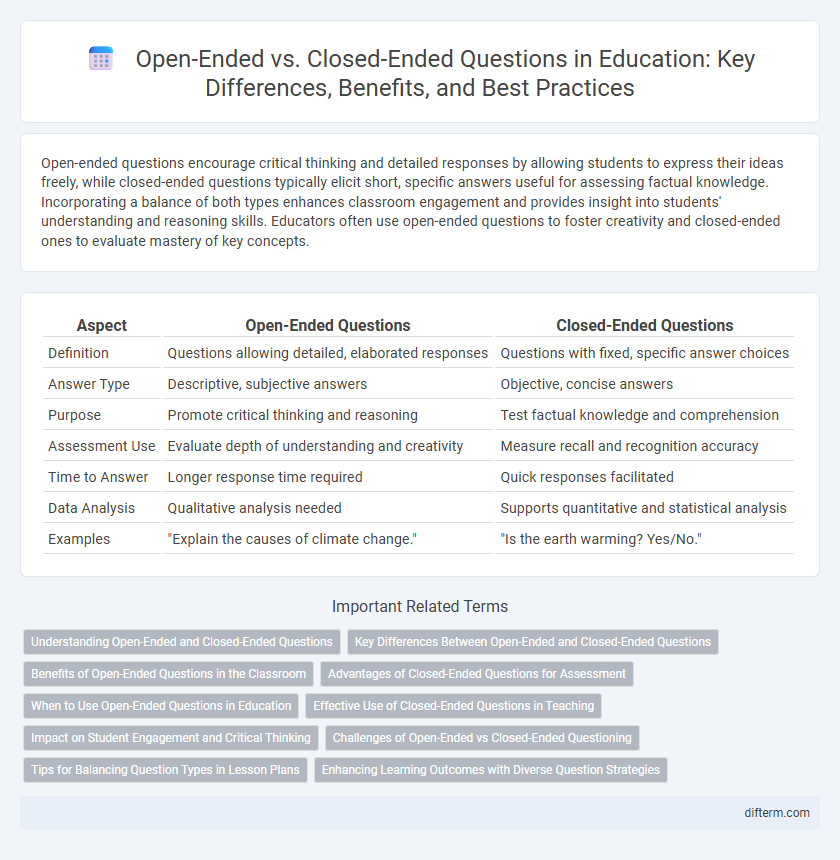Open-ended questions encourage critical thinking and detailed responses by allowing students to express their ideas freely, while closed-ended questions typically elicit short, specific answers useful for assessing factual knowledge. Incorporating a balance of both types enhances classroom engagement and provides insight into students' understanding and reasoning skills. Educators often use open-ended questions to foster creativity and closed-ended ones to evaluate mastery of key concepts.
Table of Comparison
| Aspect | Open-Ended Questions | Closed-Ended Questions |
|---|---|---|
| Definition | Questions allowing detailed, elaborated responses | Questions with fixed, specific answer choices |
| Answer Type | Descriptive, subjective answers | Objective, concise answers |
| Purpose | Promote critical thinking and reasoning | Test factual knowledge and comprehension |
| Assessment Use | Evaluate depth of understanding and creativity | Measure recall and recognition accuracy |
| Time to Answer | Longer response time required | Quick responses facilitated |
| Data Analysis | Qualitative analysis needed | Supports quantitative and statistical analysis |
| Examples | "Explain the causes of climate change." | "Is the earth warming? Yes/No." |
Understanding Open-Ended and Closed-Ended Questions
Open-ended questions encourage critical thinking and detailed responses, fostering deeper understanding and student engagement in educational settings. Closed-ended questions provide specific, concise answers that are useful for assessing factual knowledge and quickly gauging comprehension. Effective teaching strategies balance both question types to promote analytical skills while efficiently evaluating student learning outcomes.
Key Differences Between Open-Ended and Closed-Ended Questions
Open-ended questions require detailed, explanatory responses promoting critical thinking and deeper understanding, while closed-ended questions limit answers to specific, often one-word or multiple-choice options, facilitating quick assessment and data collection. Open-ended questions encourage creativity and elaborate reasoning, making them ideal for discussions and formative assessments, whereas closed-ended questions are more efficient for summative assessments and quantitative analysis. Educators leverage open-ended questions to foster analytical skills and closed-ended questions to evaluate knowledge retention objectively.
Benefits of Open-Ended Questions in the Classroom
Open-ended questions in the classroom foster critical thinking and deeper understanding by encouraging students to explore ideas rather than recall facts. They promote discussion, creativity, and the development of communication skills, which supports active learning environments. This approach enhances student engagement and allows educators to assess comprehension more effectively through diverse responses.
Advantages of Closed-Ended Questions for Assessment
Closed-ended questions streamline assessment by providing clear, quantifiable data that facilitates quick and objective grading. Their structured format minimizes ambiguity, enabling precise measurement of student knowledge and mastery of specific learning objectives. This efficiency supports standardized testing environments and aids in identifying areas needing targeted intervention.
When to Use Open-Ended Questions in Education
Open-ended questions are most effective in education when the goal is to encourage critical thinking, foster creativity, and assess deeper understanding of concepts. These questions promote student engagement by allowing diverse responses, facilitating discussions, and enabling instructors to gauge the reasoning behind students' answers. Usage is ideal during formative assessments, brainstorming sessions, and when exploring complex subjects requiring analysis and interpretation.
Effective Use of Closed-Ended Questions in Teaching
Closed-ended questions in teaching enhance student engagement by prompting concise, specific answers that help assess comprehension efficiently. They enable quick feedback, allowing educators to identify misconceptions and tailor instruction accordingly. Strategic use of closed-ended questions reinforces key concepts and supports formative assessment in diverse learning environments.
Impact on Student Engagement and Critical Thinking
Open-ended questions foster deeper student engagement by encouraging exploration and elaboration, which enhances critical thinking skills and promotes active learning. Closed-ended questions, while useful for assessing specific knowledge, often limit students' responses, reducing opportunities for meaningful analysis and creative problem-solving. Employing open-ended questions in educational settings stimulates higher-order thinking and supports the development of independent reasoning abilities.
Challenges of Open-Ended vs Closed-Ended Questioning
Open-ended questions often pose challenges in classroom settings due to their demand for critical thinking and elaborate answers, which can lead to varied student engagement and scoring difficulties. Closed-ended questions simplify assessment with clear, concise answers but may limit students' expression and depth of understanding. Balancing the use of both question types is essential for comprehensive evaluation and fostering analytical skills in educational environments.
Tips for Balancing Question Types in Lesson Plans
Incorporate a mix of open-ended and closed-ended questions to promote critical thinking while ensuring clarity and assessment efficiency. Use open-ended questions to encourage elaboration and deeper understanding, paired with closed-ended questions for quick checks of factual knowledge and student comprehension. Vary question types based on learning objectives and student needs to create a dynamic and engaging lesson plan.
Enhancing Learning Outcomes with Diverse Question Strategies
Open-ended questions foster critical thinking and deeper understanding by encouraging students to elaborate and reflect on concepts, while closed-ended questions provide clear, concise assessments of specific knowledge. Combining both strategies enhances learning outcomes by promoting engagement, allowing for diverse expression, and enabling teachers to evaluate comprehension effectively. Implementing varied questioning techniques supports differentiated instruction and cultivates higher-order cognitive skills across educational settings.
open-ended questions vs closed-ended questions Infographic

 difterm.com
difterm.com